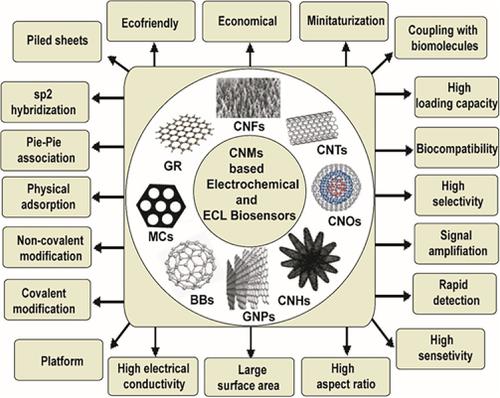当前位置:
X-MOL 学术
›
J. Chin. Chem. Soc.
›
论文详情
Our official English website, www.x-mol.net, welcomes your feedback! (Note: you will need to create a separate account there.)
Current progresses and trends in carbon nanomaterials‐based electrochemical and electrochemiluminescence biosensors
Journal of the Chinese Chemical Society ( IF 1.8 ) Pub Date : 2020-04-14 , DOI: 10.1002/jccs.201900417 Juthi Adhikari 1 , Mohammad Rizwan 1, 2 , Natasha Ann Keasberry 1 , Minhaz Uddin Ahmed 1
Journal of the Chinese Chemical Society ( IF 1.8 ) Pub Date : 2020-04-14 , DOI: 10.1002/jccs.201900417 Juthi Adhikari 1 , Mohammad Rizwan 1, 2 , Natasha Ann Keasberry 1 , Minhaz Uddin Ahmed 1
Affiliation

|
The enormous potential of biosensors in medical diagnostics has motivated scientists to develop newer innovative tools and advance biosensing technologies. The use of cell, organelles, nucleotides, aptamers, antibodies, affibodies, proteins, peptides, molecules, and printed polymers, merged with nanotechnology, offers excellent tools to prepare highly sensitive and advanced biosensors. Therefore, the current decade has witnessed a rapid surge in the fabrication of different nanomaterial‐based biosensors. Among them, carbon nanomaterials (CNMs) have emerged highly attractive in the fabrication of both electrochemical and electrochemiluminescence (ECL) biosensors. On one hand, CNMs bear prominent electrical conductivity, large surface area to immobilize adequate amount of biomolecules, an enhanced loading capacity, improved biocompatibility, and active site for electrochemical reaction. Additionally, CNMs could be chemically modified for the covalent coupling with the biomolecules. On the other hand, both electrochemical and ECL biosensors allow for cost‐effective, rapid, and real‐time detection with excellent sensitivity and selectivity, with the capability of integrating different biomolecules and CNMs on the same chip. However, currently there is not a single review, which includes CNM‐based electrochemical and ECL biosensors' current progress and trends. Therefore, this review intends to survey the current progress and future trends in CNM‐based electrochemical and ECL biosensors.
中文翻译:

基于碳纳米材料的电化学和电化学发光生物传感器的最新进展和趋势
生物传感器在医学诊断中的巨大潜力激发了科学家开发更新的创新工具和先进的生物传感技术的动力。与纳米技术结合使用的细胞,细胞器,核苷酸,适体,抗体,亲和体,蛋白质,肽,分子和印刷聚合物的使用,为制备高度敏感和先进的生物传感器提供了出色的工具。因此,当前十年见证了各种基于纳米材料的生物传感器的制造迅猛发展。其中,碳纳米材料(CNMs)在电化学和电化学发光(ECL)生物传感器的制造中都表现出了极大的吸引力。一方面,CNM具有出色的导电性,较大的表面积以固定足够数量的生物分子,增强的负载能力,改善的生物相容性,和电化学反应的活性位。另外,可以对CNM进行化学修饰以与生物分子共价偶联。另一方面,电化学传感器和ECL生物传感器都可以经济高效,快速且实时地进行检测,并具有出色的灵敏度和选择性,并且能够在同一芯片上集成不同的生物分子和CNM。但是,目前还没有一个综述,其中包括基于CNM的电化学和ECL生物传感器的当前进展和趋势。因此,本综述旨在调查基于CNM的电化学和ECL生物传感器的当前进展和未来趋势。电化学传感器和ECL生物传感器都可以实现经济高效,快速且实时的检测,并具有出色的灵敏度和选择性,并且能够在同一芯片上集成不同的生物分子和CNM。但是,目前还没有一个综述,其中包括基于CNM的电化学和ECL生物传感器的当前进展和趋势。因此,本综述旨在调查基于CNM的电化学和ECL生物传感器的当前进展和未来趋势。电化学传感器和ECL生物传感器都可以实现经济高效,快速且实时的检测,并具有出色的灵敏度和选择性,并且能够在同一芯片上集成不同的生物分子和CNM。但是,目前还没有一个综述,其中包括基于CNM的电化学和ECL生物传感器的当前进展和趋势。因此,本综述旨在调查基于CNM的电化学和ECL生物传感器的当前进展和未来趋势。
更新日期:2020-06-19
中文翻译:

基于碳纳米材料的电化学和电化学发光生物传感器的最新进展和趋势
生物传感器在医学诊断中的巨大潜力激发了科学家开发更新的创新工具和先进的生物传感技术的动力。与纳米技术结合使用的细胞,细胞器,核苷酸,适体,抗体,亲和体,蛋白质,肽,分子和印刷聚合物的使用,为制备高度敏感和先进的生物传感器提供了出色的工具。因此,当前十年见证了各种基于纳米材料的生物传感器的制造迅猛发展。其中,碳纳米材料(CNMs)在电化学和电化学发光(ECL)生物传感器的制造中都表现出了极大的吸引力。一方面,CNM具有出色的导电性,较大的表面积以固定足够数量的生物分子,增强的负载能力,改善的生物相容性,和电化学反应的活性位。另外,可以对CNM进行化学修饰以与生物分子共价偶联。另一方面,电化学传感器和ECL生物传感器都可以经济高效,快速且实时地进行检测,并具有出色的灵敏度和选择性,并且能够在同一芯片上集成不同的生物分子和CNM。但是,目前还没有一个综述,其中包括基于CNM的电化学和ECL生物传感器的当前进展和趋势。因此,本综述旨在调查基于CNM的电化学和ECL生物传感器的当前进展和未来趋势。电化学传感器和ECL生物传感器都可以实现经济高效,快速且实时的检测,并具有出色的灵敏度和选择性,并且能够在同一芯片上集成不同的生物分子和CNM。但是,目前还没有一个综述,其中包括基于CNM的电化学和ECL生物传感器的当前进展和趋势。因此,本综述旨在调查基于CNM的电化学和ECL生物传感器的当前进展和未来趋势。电化学传感器和ECL生物传感器都可以实现经济高效,快速且实时的检测,并具有出色的灵敏度和选择性,并且能够在同一芯片上集成不同的生物分子和CNM。但是,目前还没有一个综述,其中包括基于CNM的电化学和ECL生物传感器的当前进展和趋势。因此,本综述旨在调查基于CNM的电化学和ECL生物传感器的当前进展和未来趋势。


























 京公网安备 11010802027423号
京公网安备 11010802027423号